
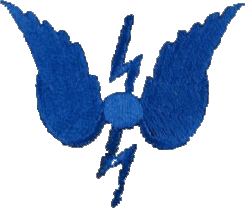

HM Signal School
K to N Blocks, RN Barracks, Portsmouth.Written by Godfrey Dykes© RN Communications Branch Museum/Library
<
Part Two
As I recorded this story from the pen of E.J. DWYER I was alerted to a book called the Story of The Royal Naval Barracks Portsmouth with a preface by Hubert Edward Dannreuther* D.S.O. R.N Commodore of the barracks [COMBRAX Portsmouth] in 1931/32 which he finished by saying "TO:- The Officers, Petty Officers and Men of His Majesty's ships, vessels and naval establishments, who may read this book, and to all other persons interested." The book is semi official cobbled together by an Admiralty librarian, unlike the first booklet I used compiled by the Instructor Lieutenant R.N.
*Commodore Dannreuther served in the battlecruiser HMS Invincible at Jutland when a shell skidded on the deck and entered the open hatch of 'Q' turret midships in the waist of the ship followed by an almighty explosion which quite literally blew the ship in half. He was one of just six survivors in a crew of over 1000 souls.
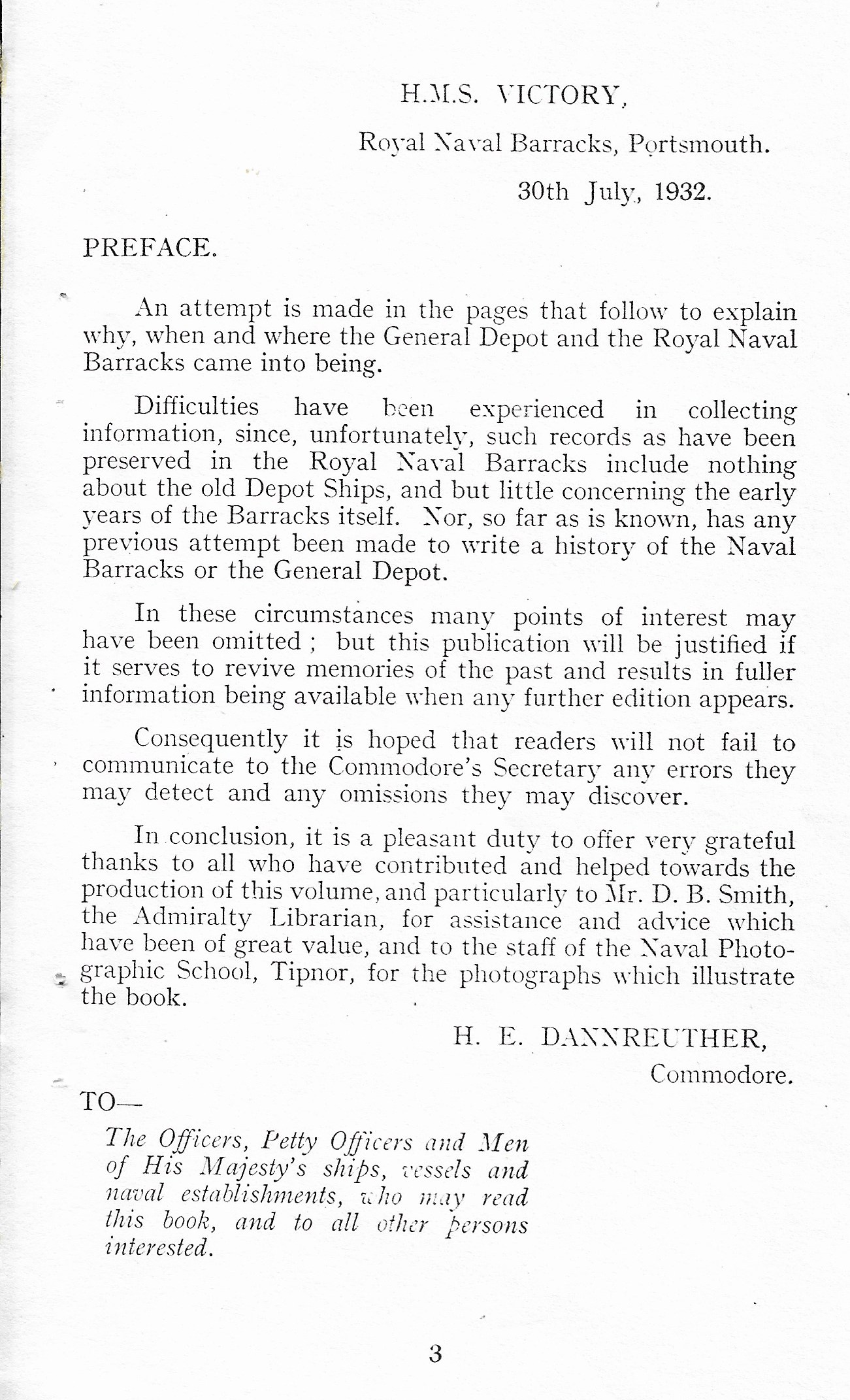
Take particular note of the commodore's para's 1 to 3 which I can accord with, there isn't much to go on unless one thinks laterally about certain naval subjects, for sometimes the navy are clueless whereas civilian records are embarrassingly au fait with naval matters. My part three - later - is a good example!
That said the book he endorses dated 1932 tells rather more than does E.J. DWYER's booklet of 1959, so I treat that as a bonus, and so starts this new part.
On page 4 of this book there is a contents list [which I won't bore you with, but it reveals that the barracks had a busy life being directly responsible for:-
a. The signal school with its experimental division.
b. The cookery school.
c. The PTI's school and the Physical-Recreational Training for pan navy.
d. The anti-gas school.
e. H.M.S. Sultan at that time afloat in Portsmouth dockyard teaching boiler the and engine room skills.
f. The Portsmouth WRNS division.
g. The vocational training school teaching skills to those about to leave the navy for civil life in approximately six months time.
h. Several trials ships acting as tenders, sea going vessels conducting experiments.
i. Several training courses for the young officers on divisional officer duties, PO rate, the WO rank, new entries, and other advancement courses.
j. Many senior officers commanding any listed letter above a to i in this list, Captains and commanders.
The barracks were opened and commissioned in 1903 but:-
The project of building Naval Barracks at Portsmouth was seriously considered in 1862, and remained under consideration for a period of over thirty years. This was due in part to the question of expense, but the main problem was to find a suitable and adequate site for the Royal Naval Barracks.
Regrettably whilst the book has many original photographs, few if any are commercially viable, useless for reproduction. I have tarted them up as far as is possible, and at least one now gets the picture [yet another pun to apologise for]. On the following page [5] of the book (re-typed),
Written by Godfrey Dykes© RN Communications Branch Museum/Library
<
Part Two
As I recorded this story from the pen of E.J. DWYER I was alerted to a book called the Story of The Royal Naval Barracks Portsmouth with a preface by Hubert Edward Dannreuther* D.S.O. R.N Commodore of the barracks [COMBRAX Portsmouth] in 1931/32 which he finished by saying "TO:- The Officers, Petty Officers and Men of His Majesty's ships, vessels and naval establishments, who may read this book, and to all other persons interested." The book is semi official cobbled together by an Admiralty librarian, unlike the first booklet I used compiled by the Instructor Lieutenant R.N.
*Commodore Dannreuther served in the battlecruiser HMS Invincible at Jutland when a shell skidded on the deck and entered the open hatch of 'Q' turret midships in the waist of the ship followed by an almighty explosion which quite literally blew the ship in half. He was one of just six survivors in a crew of over 1000 souls.

Take particular note of the commodore's para's 1 to 3 which I can accord with, there isn't much to go on unless one thinks laterally about certain naval subjects, for sometimes the navy are clueless whereas civilian records are embarrassingly au fait with naval matters. My part three - later - is a good example!
That said the book he endorses dated 1932 tells rather more than does E.J. DWYER's booklet of 1959, so I treat that as a bonus, and so starts this new part.
On page 4 of this book there is a contents list [which I won't bore you with, but it reveals that the barracks had a busy life being directly responsible for:-
a. The signal school with its experimental division.
b. The cookery school.
c. The PTI's school and the Physical-Recreational Training for pan navy.
d. The anti-gas school.
e. H.M.S. Sultan at that time afloat in Portsmouth dockyard teaching boiler the and engine room skills.
f. The Portsmouth WRNS division.
g. The vocational training school teaching skills to those about to leave the navy for civil life in approximately six months time.
h. Several trials ships acting as tenders, sea going vessels conducting experiments.
i. Several training courses for the young officers on divisional officer duties, PO rate, the WO rank, new entries, and other advancement courses.
j. Many senior officers commanding any listed letter above a to i in this list, Captains and commanders.
The barracks were opened and commissioned in 1903 but:-
The project of building Naval Barracks at Portsmouth was seriously considered in 1862, and remained under consideration for a period of over thirty years. This was due in part to the question of expense, but the main problem was to find a suitable and adequate site for the Royal Naval Barracks.
Regrettably whilst the book has many original photographs, few if any are commercially viable, useless for reproduction. I have tarted them up as far as is possible, and at least one now gets the picture [yet another pun to apologise for]. On the following page [5] of the book (re-typed),

List of Illustrations |
| 1. H.M.S. Duke of Wellington in Portsmouth Harbour. 2. The old General Depot - H.M. Ships Duke of Wellington and Marlborough alongside the Dockyard wall. 3. Mobilisation parade, H.M.S. Duke of Wellington, 10th July, 1900. Inspection by Captain H.R.H. the Duke of York, Royal Navy. 4. The Lion and the Unicorn Gates. 5. Plans of the old Garrison Hospital and the Anglesey Military Barracks, Portsea. 6. Maps of Portsea, shewing- (a) The Old Defences, 1770-1870. 7. The R.N. Barracks Parade Ground. 8. The Officers' Mess. 9. The Clock Tower and the Signal School from the Parade Ground. 10. Signal School - Visual Signalling instruction room. 11. Signal School - Wireless instruction. 12. The Gymnasium of the P. & R.T. School, Pitt Street. 13. The Swimming Bath, Pitt Street. 14. The Warrant Officers' Mess. 15. The Chief Petty Officers' and Petty Officers' Messes - formerly the Soldiers' Quarters of the Anglesey Barracks. 16. W.R.N.S. Squad drill competition held at Whale Island, 30th April, 1919, won by a Squad from the R.N. Barracks (vide page 79). (Note. - In the centre of the group is Commodore Dannreuther, at that time Commander of H.M.S. Excellent.) 17. The Bluejacket Band, Royal Naval Barracks, 1932. (Note. - The band is composed of volunteers, and was originally formed in 1921.) |
There are several pictures of immediate interest to our story directly concerning the H.M. Signal School. They are No2, No5, No9, No10, No11, No14 and No15
No2 = the two biggest ships the William IV/Victorian/Edwardian navy ever had were enormous especially the Duke of Wellington a 130 gun ship of the line, Here they are as mastless hulks alongside near Asia Pontoon in the vicinity of Fountain Lake in the yard. Marlborough was also completed as a 130 gun vessel but much to the discomfort of the crew! Incidentally the HMS DofW was launched as HMS Windsor Castle. When the Duke died it was re-christened HMS Duke of Wellington.
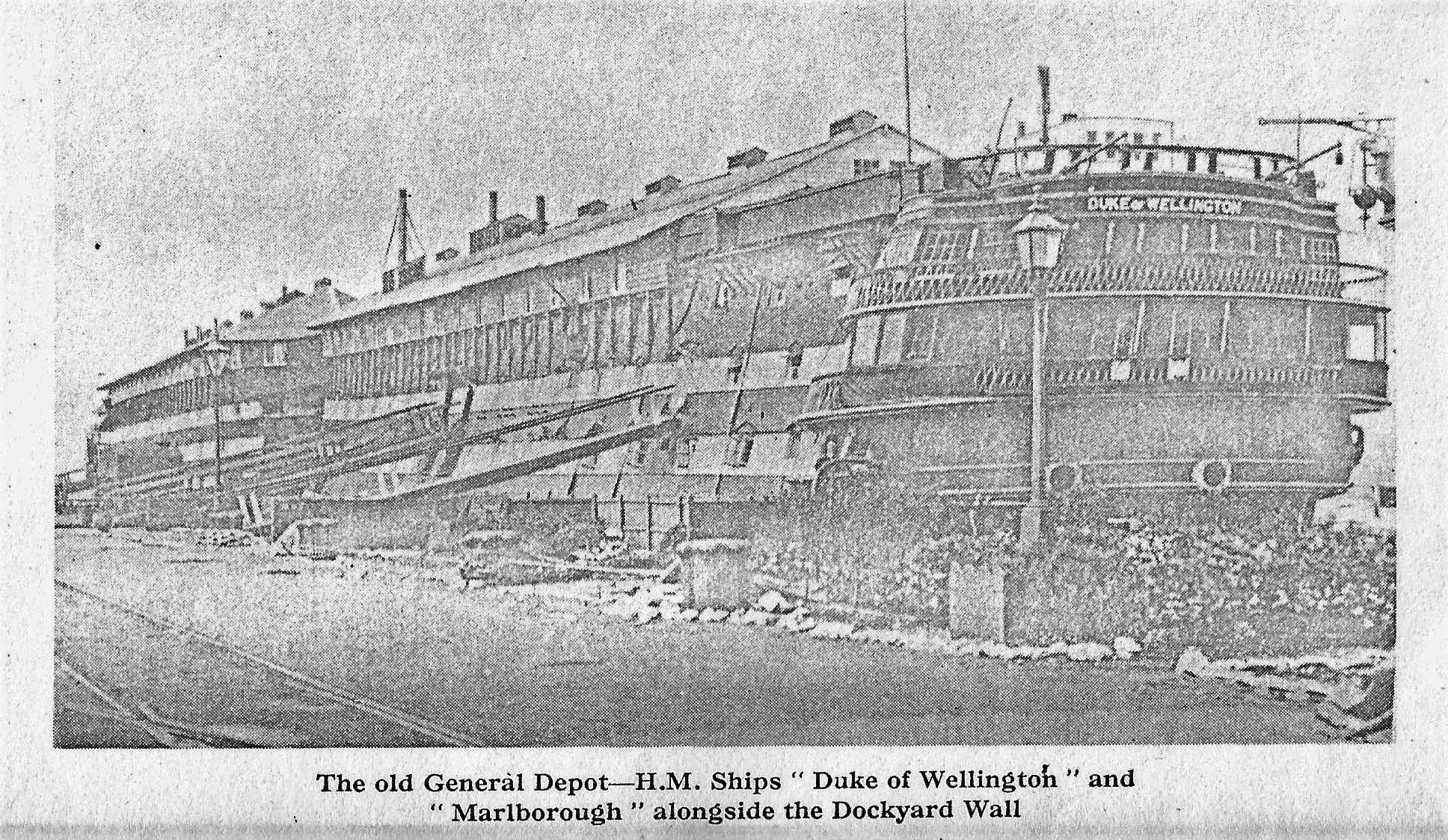
No5 = The old Garrison Hospital which in part became HMS Nelson's Wardroom wherein both staff and trainee signals officers lived. The enormous free space behind the hospital was used to create a stunningly beautiful garden.
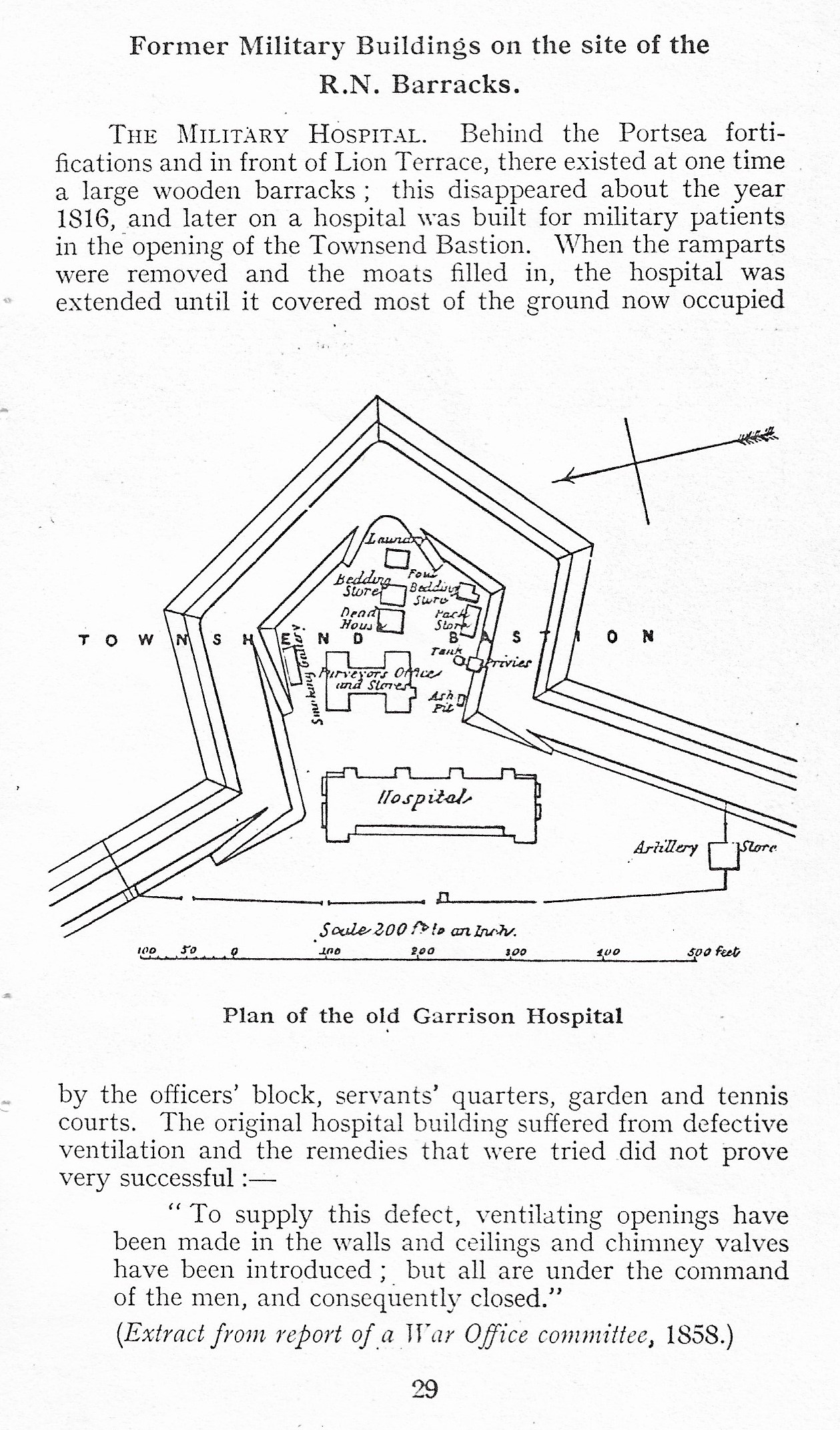
No9 = The Clock Tower and the Signal School from the parade ground
In the picture below one can see the barrack clock tower attached to the gymnasium and over to the left the towering huge blocks of the Signal School seeing building K and at the back building M. Buildings [L and N [or V] are out of camera shot]. In front of K block [and L if you could see it] you can see low level buildings called hutlets which in all, form the signal school experimental blocks. For their entire existence senior officers of the navy and those serving in the barracks complained about how unsightly they looked when compared with the beautifully designed and build barrack blocks, and all considered them an eyesore. The V/S signalling flag hoist mast is easily recognised, but behind it is the school's very tall radio mast currently masked by the V/S mast. If you look above the letter 'a' in 'and' in the picture's title, you will see the arched door way where all the signals officer photographs were taken clearly marked with the letter 'K' over the door, as well as the Signal School rather large sign.
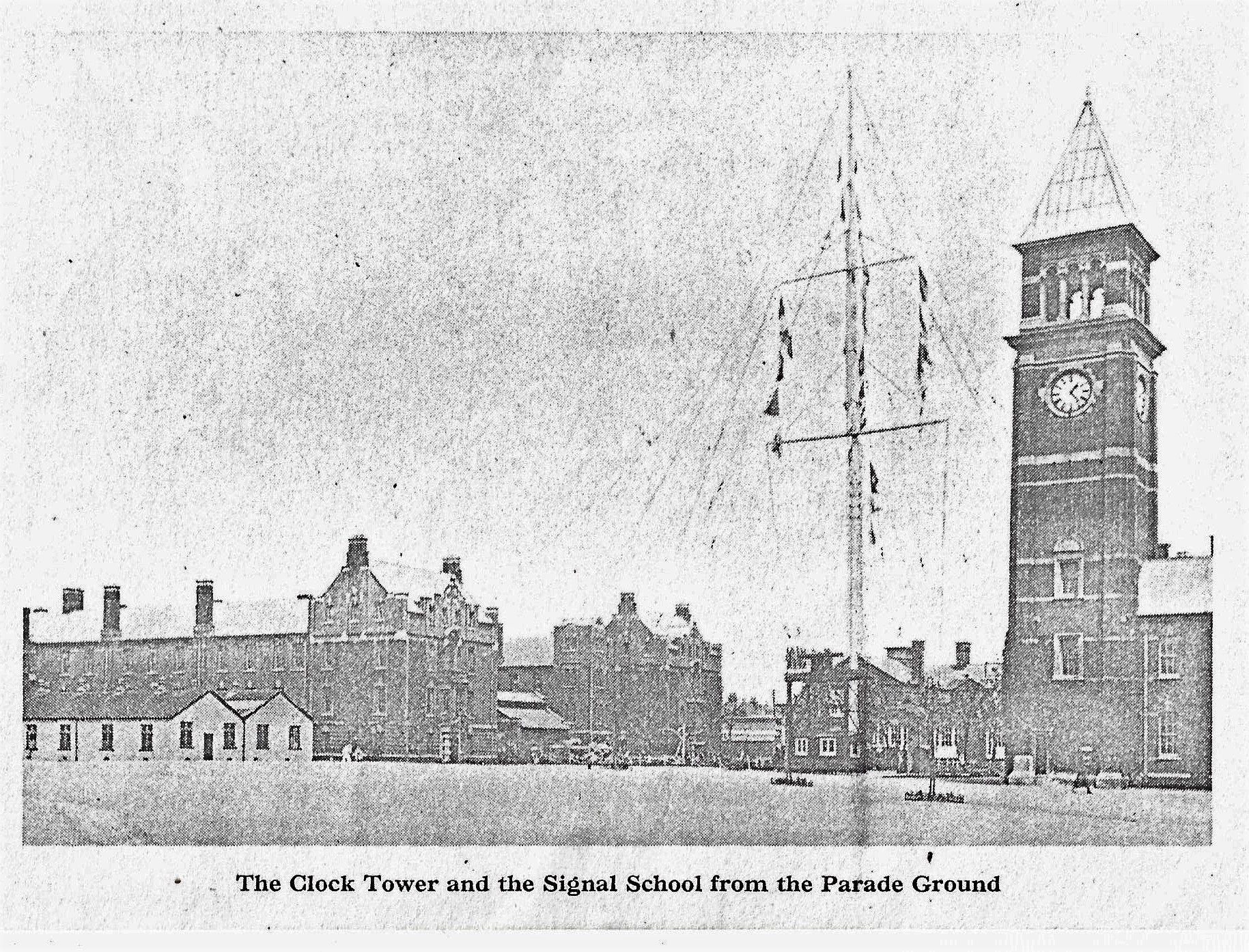
No10 = Signal School V/S instruction Room which you would have seen in Part 1 was yet another use for the main barrack block, the others being hammock slinging, dining area and recreational space. Note the many framed pictures on the far bulkhead presumably of flag hoists etc.
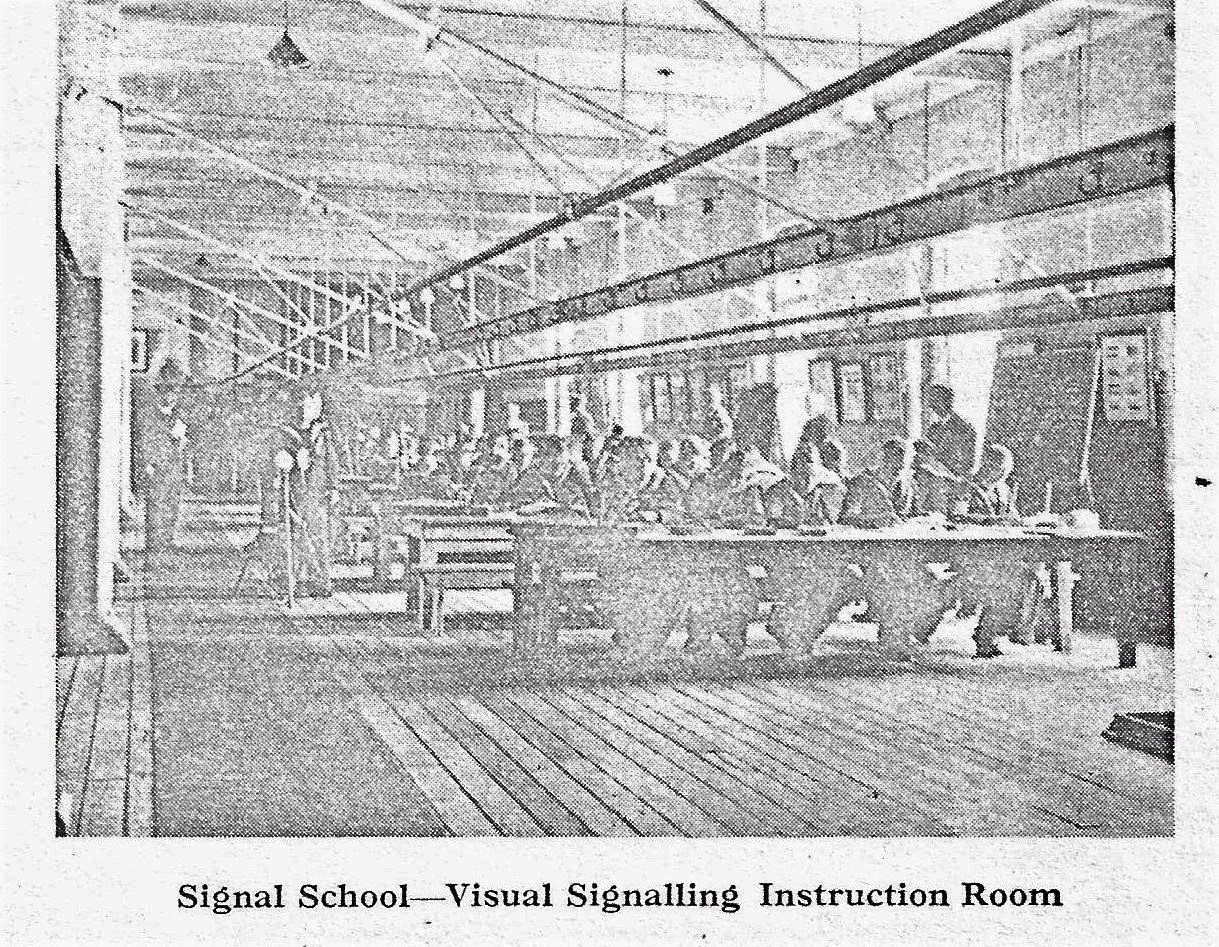
Signal School Wireless Telegraphy instructions. Note the instructor sitting behind and his two buttons sewn onto the back of his jacket cuffs depicting a CPO - no three buttons in those days for ratings reserved for WO's, and all PO's, 1st and 2nd class wore square rig.
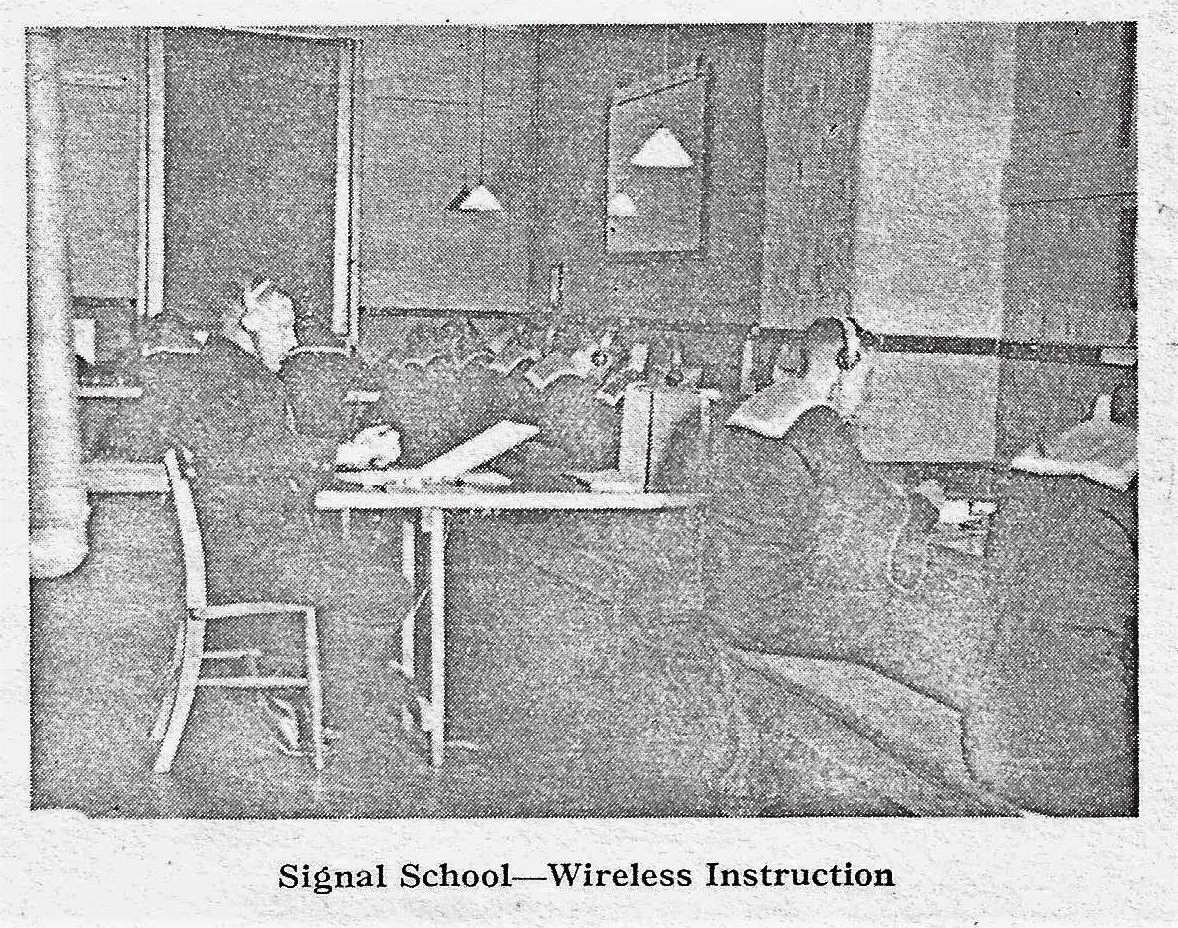
No14 = WO's Mess. It was much too small for the numbers borne, the excess living in various parts of the signal school blocks. Note the signal school's tall W/T mast to the right and part of the signal school appearing into view also on the right.
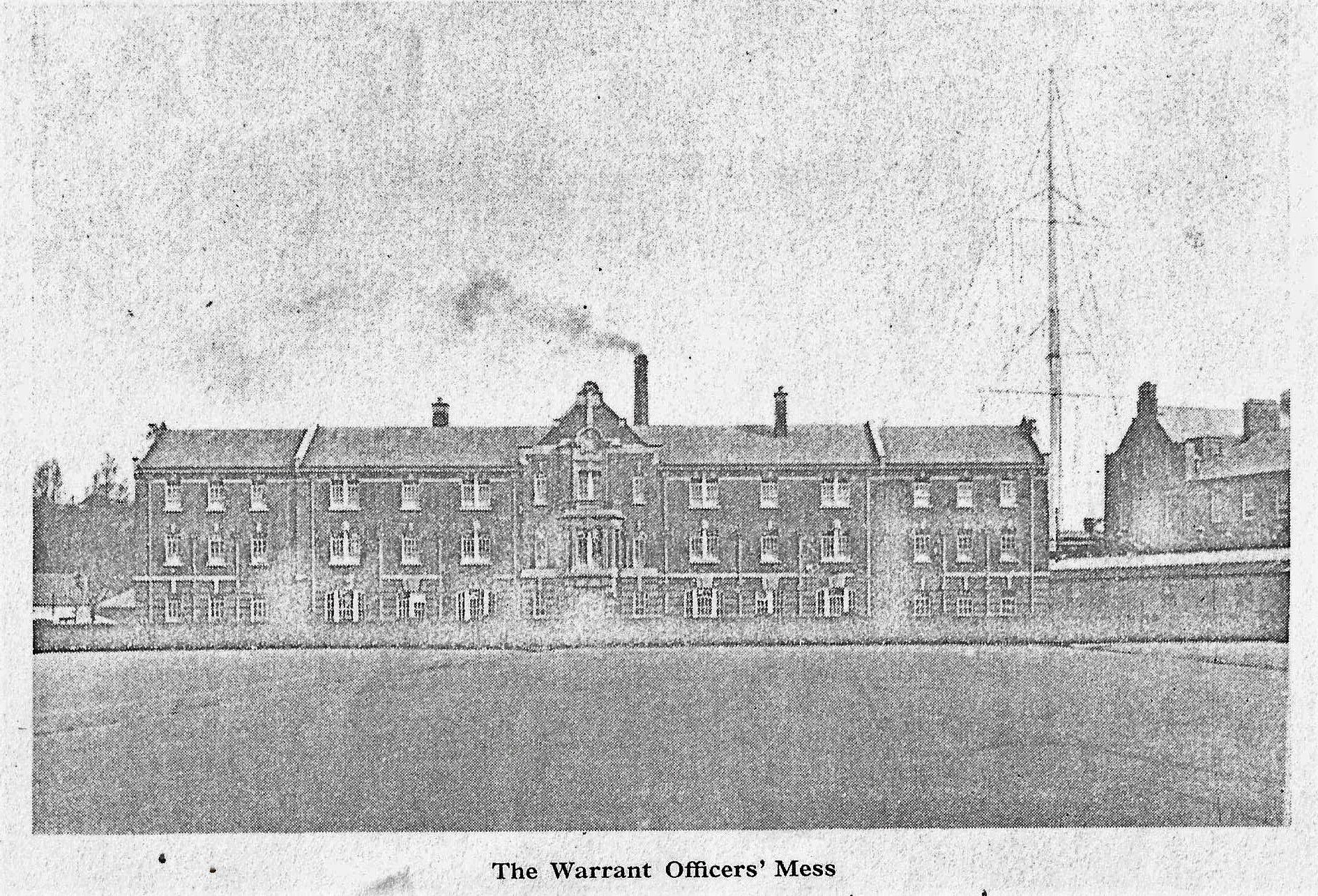
No15 = The CPO's mess wherein lived many instructors who weren't WO's or commissioned officers. This was one of a tiny number of buildings which were used by the infantry when Anglesey Barracks and in which lived the ordinary soldiers. You'll see how it fits in when you see old sketches of the 19th century barracks in Part One. It had a major face lift before it was given over to RN CPO's/1st Class PO's.
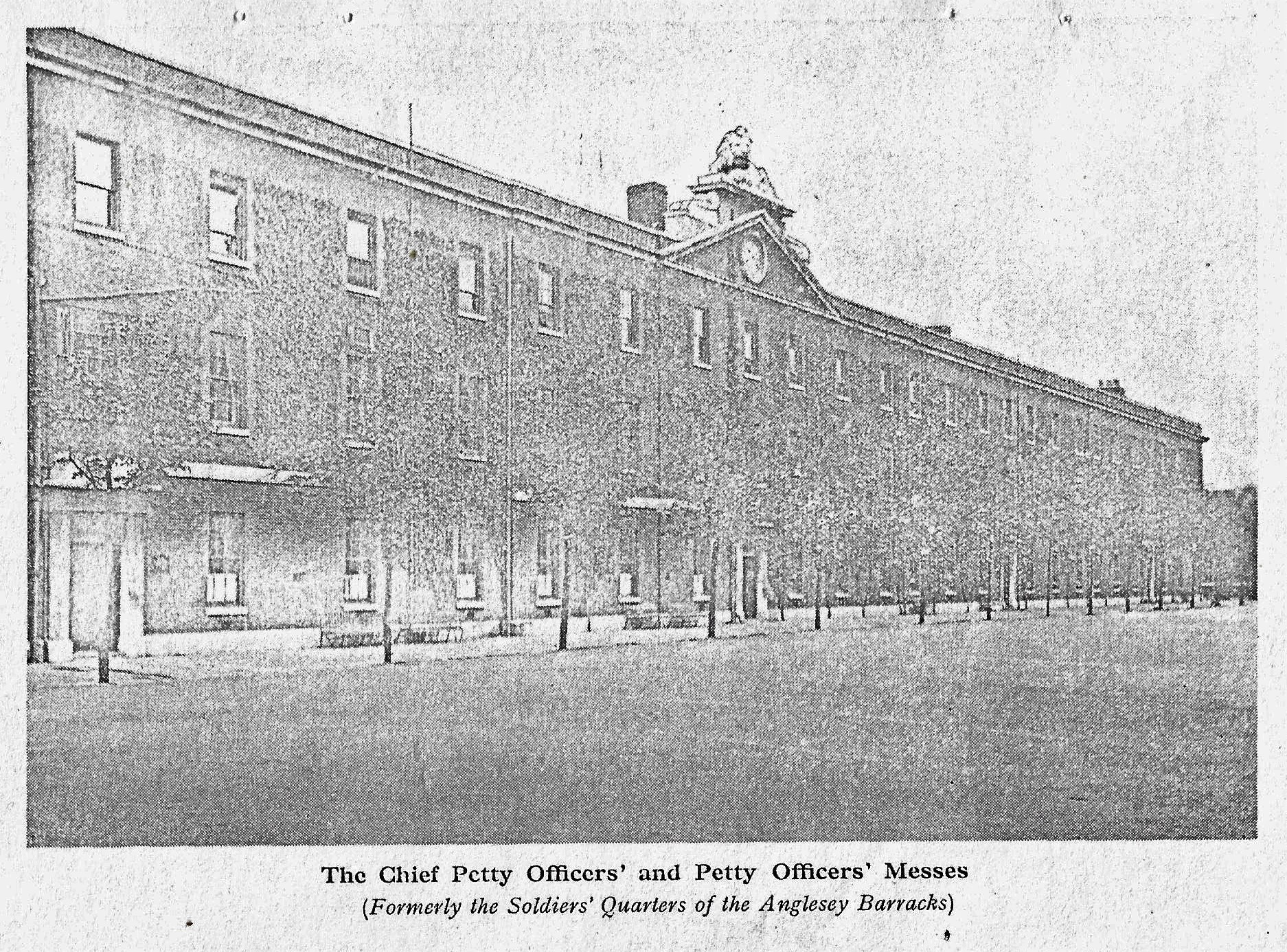
The main RNB plan as at 1932. Note 'K' block well marked as the signal school. Use your magnifier for the finer detail. Note signal school hutlets not shown! Note how the main gate to the yard was not shown as being at the end of Queen Street on the open Hard,
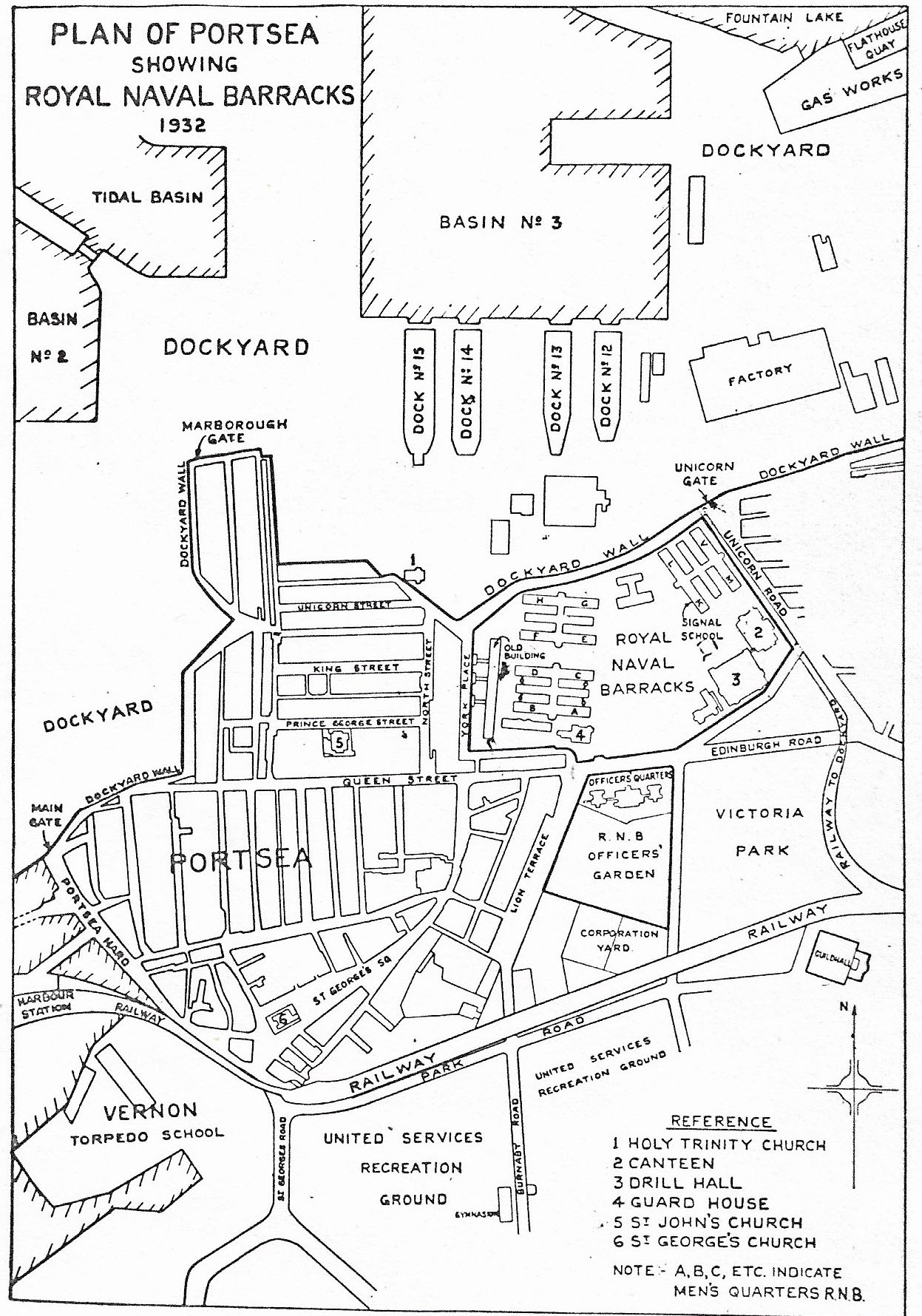
The following file covers various topics regarding the Signal School including:-
COs of the Signal School, Staffing of Signal School, Transfer of the Signal School, The Pigeon Service,
Wireless Telegraphy, The C.S.S., The Great War 1914-1918, Signal and Wireless Instruction,The Experimental Department, Seagoing Tenders and attached Ships.
Signal School topics
An important signal school function achievement!
Portsmouth in earlier times was more of an Army Garrison town than a naval town despite its long established role in the defence of our illustrious nation. On ceremony the two forces often paraded together but the navy were always considered lack lustre even though their marching and drill was a match for most soldiers except perhaps the PBI know coloquially throughout the land as the 'Poor Bloody Infantry' for their way of hand to hand fighting and as such great losses.
Now read this.
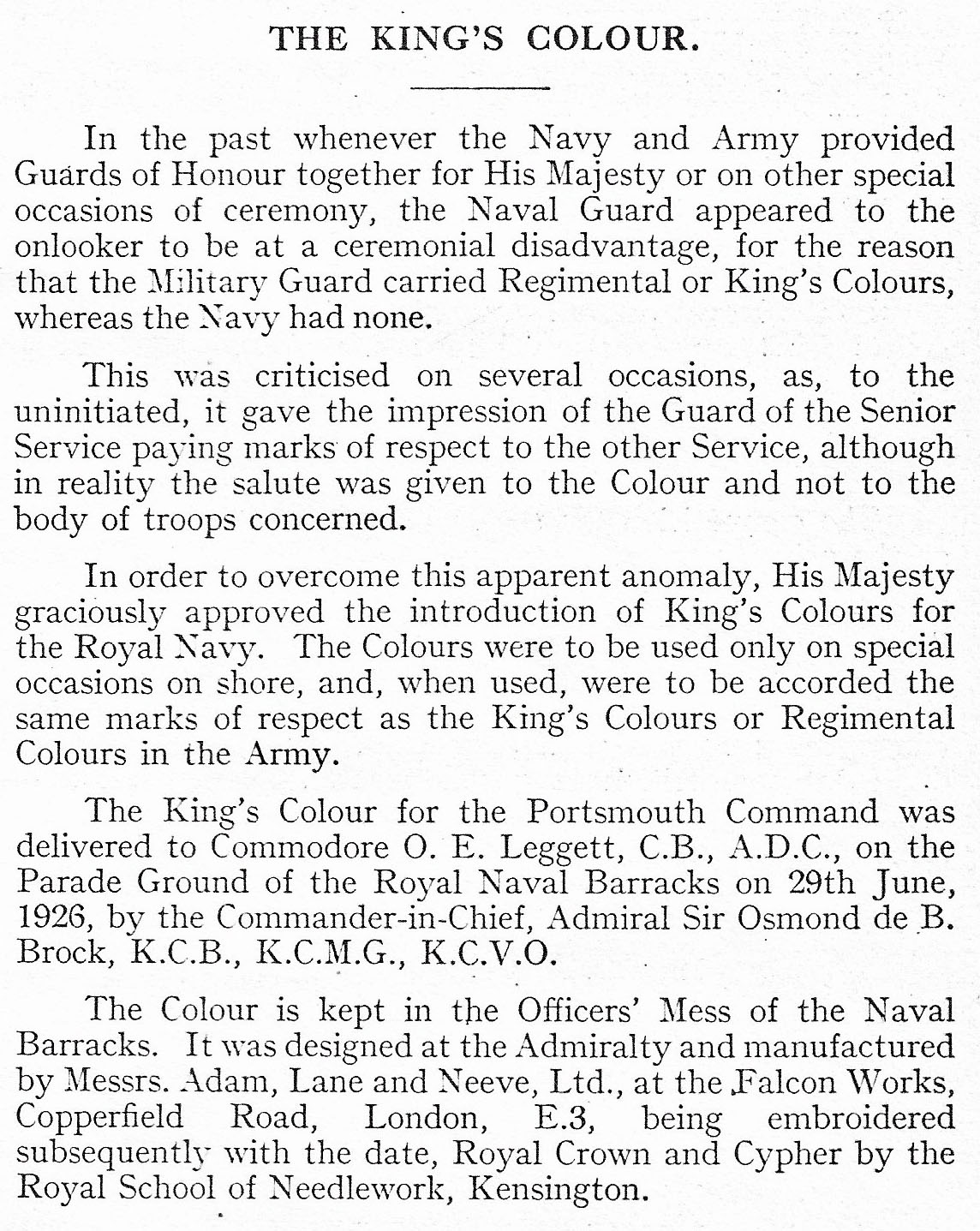
When it came to flag wagging none was better or more skillful than the VS Branch of the Royal Navy. When it came to drill, from their involvement in Queen Victoria's funeral at Windsor in 1901 [which became a major gear change for Whale Island] through to current times, hopefully, with a depleted navy and it has to be said a mixed gender phalanx of sailors and rarely are women collectively good at ceremony as undoubtedly men collectively are, we can still come up with the goodies now one one fifth already into the 21st century. As it tells one above, finally with the push from naval ceremonial drill and the use of flags per se whatever the cause or reason, we were able to pull ourselves our of the doldrums as regards to lacking a certain panache which having a depot standard means, especially when the depot standard can be used in outlying establishments as well as centrally, RNB or on the streets of dear Pompey. For example, HRH The Duchess of Kent, a great advocate of our Colours particularly in Portsmouth but in other depots too and in other divisions other than the surface fleet e,g, the fleet air arm and the submarine service, brought the Portsmouth Colours to HMS Mercury to be paraded with great honour and lasting pride. C.S.S., and the Barracks Parade Commander and relevant staffs were to be congratulated in bringing this deserving case to the attention of C-in-C Portsmouth upped to the Admiralty and onwards to Buckingham Palace for King George V to action and approve.
Another feather in the cap of H.M. Signal School was RNB's famous annual event called the Dupree Cup which the signal school won three times on the trot.
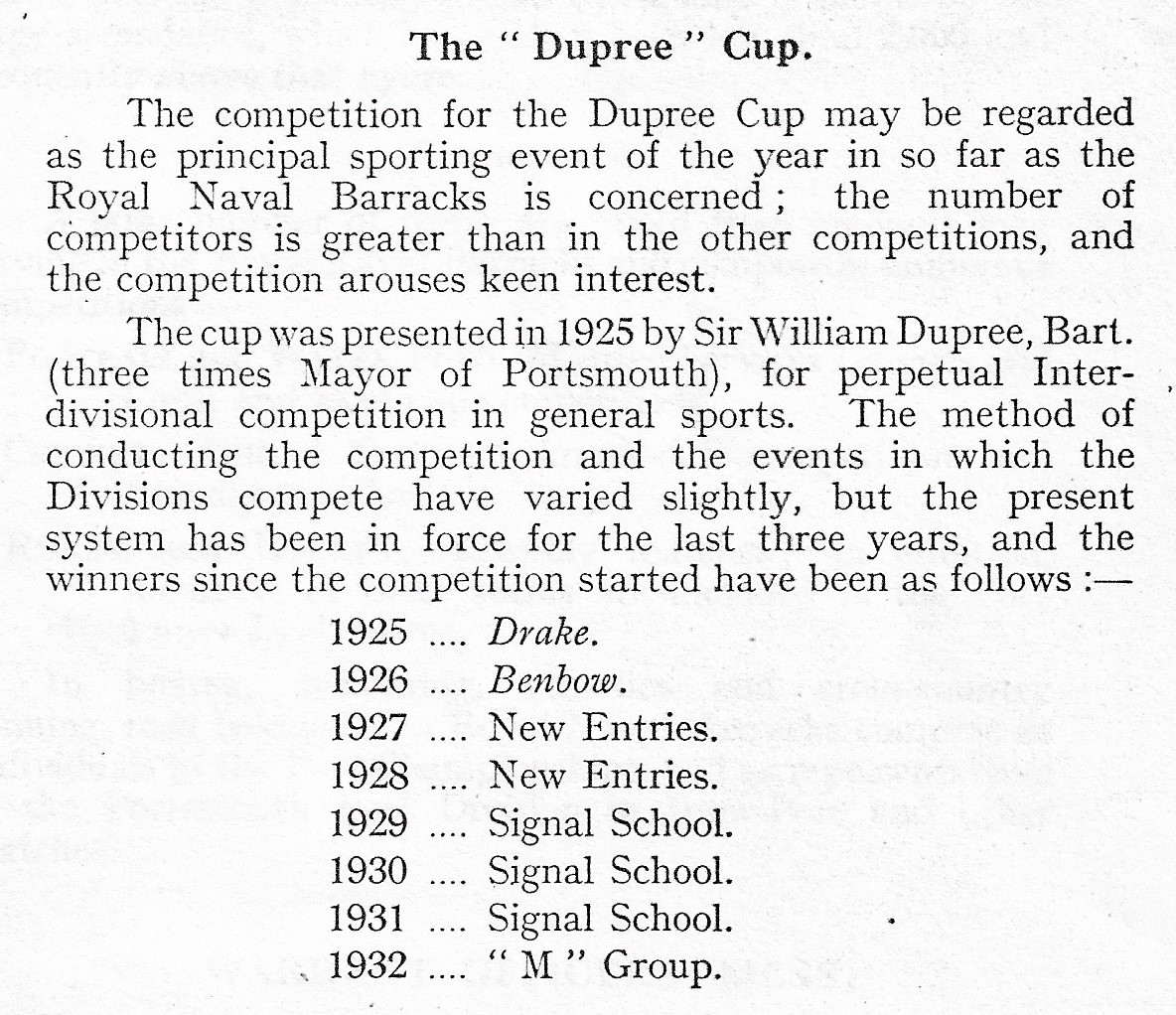
The Dupree Challenge Cup, an annual award took the form of:-
Highest aggregate for several one mile races and for hurdle races.
Inter-block challenge cup for tug-of-war.
Inter-room challenge shield for annual billiards tournaments.
Inter-room challenge cups for Football, Cricket, Bayonet Team, Acquatic Team Race and field gun competition.
and FINALLY
This time, I moved away from naval data sources and thought laterally as opposed to logically and chose the British Library and their difficult to find Thesis section which the Library calls 'Ethos', hoping to find a PhD scholar who had done the spade work for me, indeed for us all, as you will see. Once again in my many experiences which are several, I found a Thesis called "Technology and Tradition - Wireless Telegraphy and the Royal Navy 1895-1920 written by A.J.L. Blond, a mature student studying in the Department of History, University of Lancaster, March 1993" the Copyright owner along with the host site, the British Library. This Thesis could well have been written for this web page and more specifically for the academic side of our Museum and site https://www.commsmuseum.co.uk/ , the web site of the Royal Naval Communications Branch Museum Library. We are grateful for the use of this document modified for our needs assuming we are allowed to use this data, long overdue for entering into the naval environs from its inception twenty seven years ago lying fallow.
I'll quote you four statements from the Thesis all in Chapter 3 Personnel and Organisation 1896-1914, which sets the scene for the early years of the 20th century.
The first was an admittance that because of branch fall outs and internal wranglings from the 1890's to 1912 we were not ready for WW1 being severely depleted of telegraphists which during that time frame we are told were like gold dust!
Second, the army after four years of trench warfare and its accompanying attrition rate very nearly lost the field as the naval shortage of telegraphists very nearly saw the end of convoys and other fleet operations.
Thirdly, Jellicoe said:-

and finally Beatty said:-
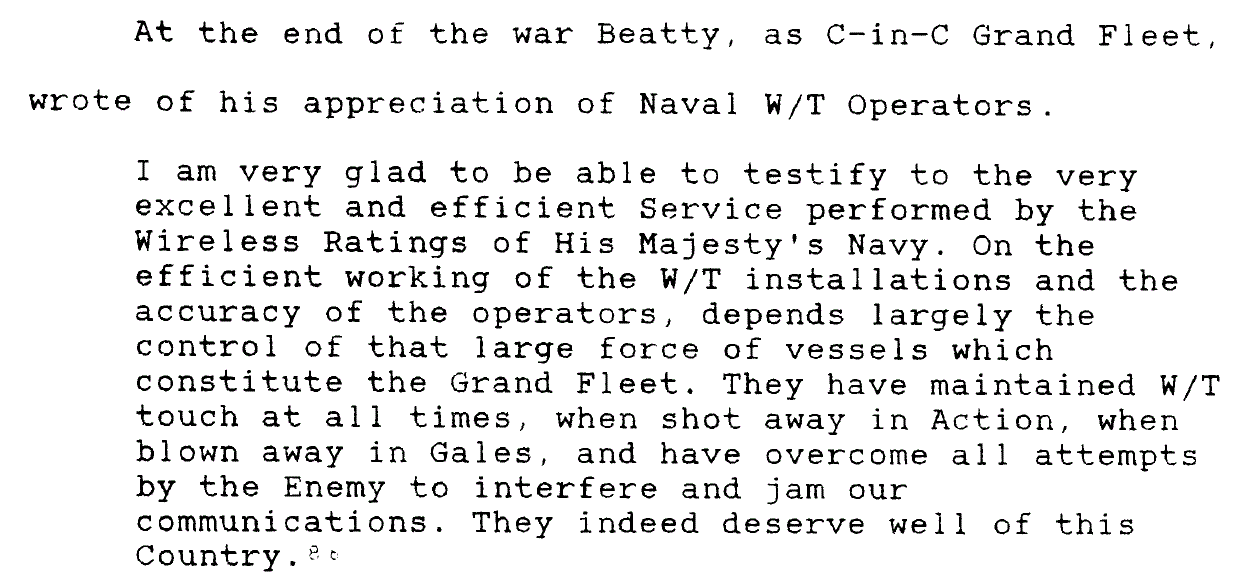
I remember well compiling the history of the W/T branch for the CHC Site and this site for period 1900-1913 which told of a rocky and laboured journey from the early days of Marconi and Jackson to the largest war fleet ever assembled and well fitted with sophisticated W/T equipment but lacking the skilled men required to operate it and how that frustrated our ability to deploy that/those fleets to their full potential. This Thesis goes into the subject much more deeply and in just about every sentence, touches upon a raw nerve that without telegraphists in the numbers required we were never going to be as successful as the money and time spent in developing this new technology suggested. Whilst expecting H.M. Signal School to be a leading light in resolving this issue, one is bound to be disappointed, for long after its establishment in RNB Portsmouth, the Vernon Signal School was still dictating policy and calling many of the shots, and the Admiralty had no plans to pull the naval Signal Schools into a unified organisation. Because of the length of the Thesis, I recommend that one at least reads Chapter Three [but of course more for a detailed understanding] before moving on to the applied story starting from "My first file" just below.
No5 = The old Garrison Hospital which in part became HMS Nelson's Wardroom wherein both staff and trainee signals officers lived. The enormous free space behind the hospital was used to create a stunningly beautiful garden.
No9 = The Clock Tower and the Signal School from the parade ground
In the picture below one can see the barrack clock tower attached to the gymnasium and over to the left the towering huge blocks of the Signal School seeing building K and at the back building M. Buildings [L and N [or V] are out of camera shot]. In front of K block [and L if you could see it] you can see low level buildings called hutlets which in all, form the signal school experimental blocks. For their entire existence senior officers of the navy and those serving in the barracks complained about how unsightly they looked when compared with the beautifully designed and build barrack blocks, and all considered them an eyesore. The V/S signalling flag hoist mast is easily recognised, but behind it is the school's very tall radio mast currently masked by the V/S mast. If you look above the letter 'a' in 'and' in the picture's title, you will see the arched door way where all the signals officer photographs were taken clearly marked with the letter 'K' over the door, as well as the Signal School rather large sign.
No10 = Signal School V/S instruction Room which you would have seen in Part 1 was yet another use for the main barrack block, the others being hammock slinging, dining area and recreational space. Note the many framed pictures on the far bulkhead presumably of flag hoists etc.
Signal School Wireless Telegraphy instructions. Note the instructor sitting behind and his two buttons sewn onto the back of his jacket cuffs depicting a CPO - no three buttons in those days for ratings reserved for WO's, and all PO's, 1st and 2nd class wore square rig.
No14 = WO's Mess. It was much too small for the numbers borne, the excess living in various parts of the signal school blocks. Note the signal school's tall W/T mast to the right and part of the signal school appearing into view also on the right.
No15 = The CPO's mess wherein lived many instructors who weren't WO's or commissioned officers. This was one of a tiny number of buildings which were used by the infantry when Anglesey Barracks and in which lived the ordinary soldiers. You'll see how it fits in when you see old sketches of the 19th century barracks in Part One. It had a major face lift before it was given over to RN CPO's/1st Class PO's.
The main RNB plan as at 1932. Note 'K' block well marked as the signal school. Use your magnifier for the finer detail. Note signal school hutlets not shown! Note how the main gate to the yard was not shown as being at the end of Queen Street on the open Hard,
The following file covers various topics regarding the Signal School including:- COs of the Signal School, Staffing of Signal School, Transfer of the Signal School, The Pigeon Service, Wireless Telegraphy, The C.S.S., The Great War 1914-1918, Signal and Wireless Instruction,The Experimental Department, Seagoing Tenders and attached Ships.



